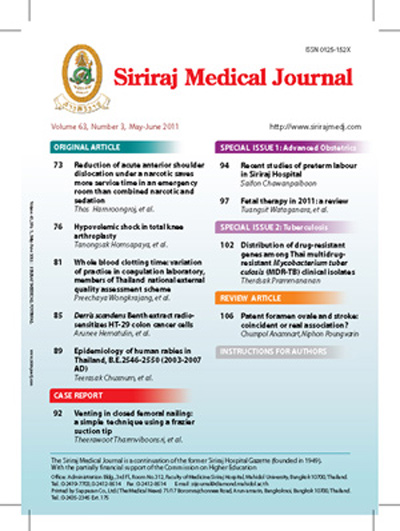Venting in Closed Femoral Nailing: A Simple Technique Using a Frazier Suction Tip
Keywords:
Vent; femoral nailing; intramedullary pressure; fat embolismAbstract
A surgical technique to drain the medullary content during closed femoral nailing by using a Frazier suction tip as
a vent is demonstrated. This method is simple, safe and reproducible. The medullary content can be drained outside without
surrounding soft tissue contamination and the intramedullary pressure is possibly minimized when femoral canal reaming and
nail insertion is performed.
References
Surg Br. 1995;77:450-5.
2. Pell AC, Christie J, Keating JF, Sutherland JR. The detection of fat embolism by transesophageal echocardiography during reamed intramedullary
nailing: a study of 24 patients with femoral and tibial fractures. J Bone Joint Surg Br. 1993;75:921-5.
3. Husebye EE, Lyberg T, Madsen JE, Eriksen M, Roise O. The influence of a one-step reamer-irrigator-aspirator technique on the intramedullary pressure in the pig femur. Injury. 2006 Oct;37(10):935-40.
4. Jones RH. Physiologic emboli changes observed during total hip replacement arthroplasty. A clinical prospective study. Clin Orthop. 1975;112:192-200.
5. Martin R, Leighton RK, Petrie D, et al. Effect of proximal and distal venting during intramedullary nailing. Clin Orthop. 1996;332:80-9.
6. Sturmer KM. Measurement of intramedullary pressure in an animal experiment and propositions to reduce the pressure increase. Injury. 1993;24 Suppl:S7-21.
7. Ulrich C. Value of venting drilling for reduction of bone marrow spilling in cemented hip endoprosthesis. Orthopedics. 1995;24:138-43.
8. Pape HC, Zelle BA, Hildebrand F, Giannoudis PV, Krettek C, van Griensven M. Reamed femoral nailing in sheep: does irrigation and aspiration
of intramedullary contents alter the systemic response? J Bone Joint Surg Am. 2005 Nov;87(11):2515-22.
Downloads
Published
How to Cite
Issue
Section
License
Authors who publish with this journal agree to the following conditions:
Copyright Transfer
In submitting a manuscript, the authors acknowledge that the work will become the copyrighted property of Siriraj Medical Journal upon publication.
License
Articles are licensed under a Creative Commons Attribution-NonCommercial-NoDerivatives 4.0 International License (CC BY-NC-ND 4.0). This license allows for the sharing of the work for non-commercial purposes with proper attribution to the authors and the journal. However, it does not permit modifications or the creation of derivative works.
Sharing and Access
Authors are encouraged to share their article on their personal or institutional websites and through other non-commercial platforms. Doing so can increase readership and citations.











